GRANTHAM PARK
Grantham Park was located on north side of what is now known as Dewsbury Road, Upper Edge. The area was used for various sporting activities during the mid to late Victorian era. The sports usually involved gambling and extraordinary amounts of money exchanged hands.
Grantham was located on the north side of Dewsbury Road, Upper Edge, prior to reaching Upper Edge Baptist Church and the Five Acre Quarry.
It is shown on the 1893 maps below.
In the mid 1800’s, Grantham had a park that was known nationally for a variety of sporting occasions.
To the annoyance of many, gambling and sport appear to go hand in hand today and it was no different in those days either. Betting on the outcome of sporting events was huge and this was frequently organised by the landlord of the local public house who would occasionally provide prizes but usually, he was also the bookmaker who was looking to cash in with the punters money.
Bell’s Life in the London & Sporting Chronicle dated 22nd February 1857 reported on a shooting competition at Grantham Park and informs the reader that Mr. Barratt was the landlord of the Black Bull, Elland Edge (until recently, the Pinfold Hotel). As he was also the proprietor of the sports ground, it was in his interest to promote as many events as he could. If good prize money was made available, the leading sportsmen would compete. This ensured large crowds who would pay an admission fee, have a drink or two in the pub and probably have a bet too. No doubt his hostelry would do a roaring trade, so the landlord benefitted all round.
Today, many people would be horrified to discover what was happening on our doorsteps over 160 years ago, in the name of sport. I suspect that nowadays, protestors would be out in force and demonstrating about some of the practices as they are now considered barbaric.
So what types of activity went on at Grantham Park and why was this location so popular ?
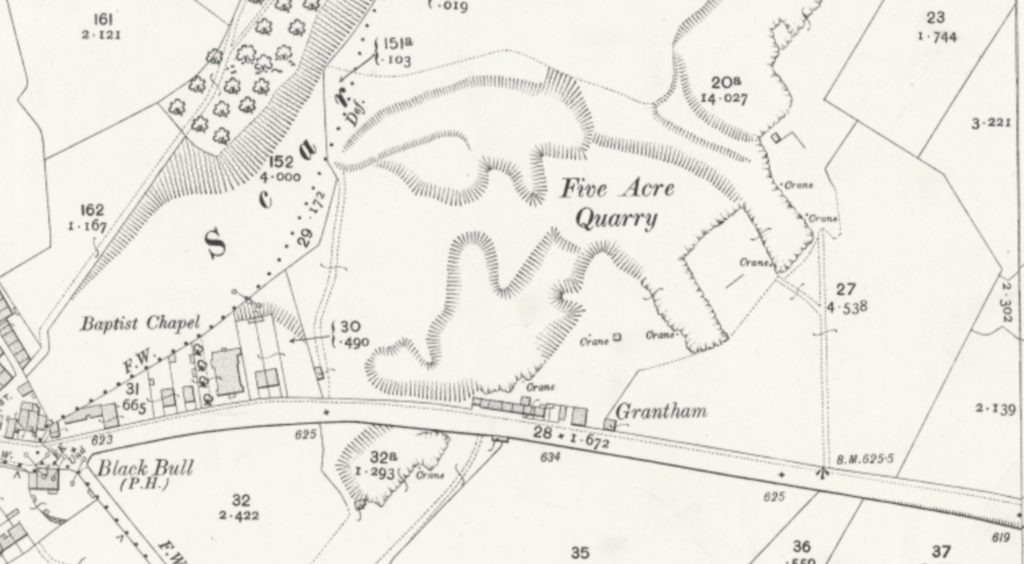
LIVE PIGEON SHOOTING
Live pigeon shooting is a direct ancestor to what is now called single or double trap shooting. Team GB won bronze medals at the Rio Olympics in both of these events in 2016 but today (30th July 2024) Nathan Hales won the gold medal in the mens trap final at the Paris games. Nowadays we call the targets ‘clay pigeons’ whereas they used to be live birds. The device that fires the clays is called the trap, hence a single trap will release one clay whilst a double will release two.
Originally, the trap was a cage with either one or two birds inside. We now shout ‘pull’ for a clay to be released whereas with the live birds, the ‘puller’ or ‘trapper’ pulled a string to open a hatch to release the birds from the trap, as shown in this drawing to the right.
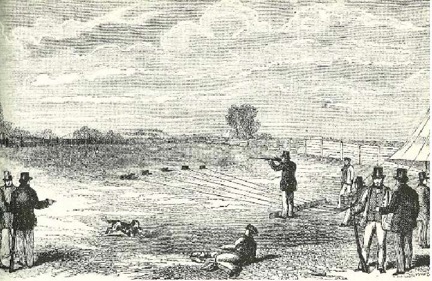
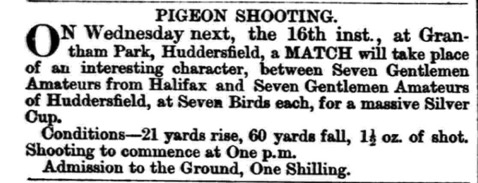
There were various different types of competition with distinct rules for each but the general idea was to kill as many birds as possible and get the punters to gamble as much money as was achievable. This advert is from the Huddersfield Chronicle dated 12thMarch 1864 and involved seven gentlemen from Halifax taking on seven gentlemen from Huddersfield for the prize of a massive silver cup. Note the entry charge of one shilling.
The result of the competition was reported in the same newspaper on the 19thMarch 1864 where it states that each gentleman fired at nine pigeons and the Huddersfield team were victors by forty-four birds to thirty-nine.

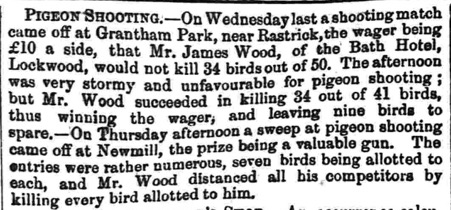
On the 30thNovember 1861, the Huddersfield Chronicle reported upon a match where the betting was on James Wood of Lockwood not killing thirty-four birds out of fifty for £10 a side, not a mean amount of money considering that the average wage in the UK at that time was around £1 per week.
If you think £10 was a good amount, the previous year had seen a substantial £100 a side wagered for a shoot at one hundred birds over two days in April 1860. This also involved the above mentioned James Wood who was the champion pigeon shooter of England.

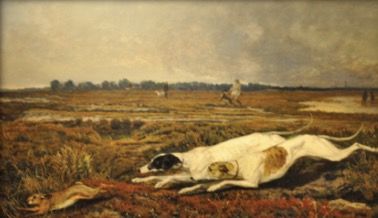
RABBIT COURSING
The working class sport of rabbit coursing also took place at Grantham Park. Again, most matches were organized by the landlord of the Black Bull. Two dog owners would put up cash stakes and their greyhounds or whippets would give the live rabbit between forty to sixty yards start. The dogs were then released to give chase. The dogs were faster than the rabbit but the rabbit was more agile and performed turns to try to evade the hunters. It usually resulted in one outcome and it was the dog that caught the rabbit that was declared the winner. Often, the landlord would add to the prize money to make it even more attractive and he would also usually provide the rabbits. Part of the thrill for the crowd was the brutal and unpleasant destruction of the rabbit by the dog.
Bell’s Life in London and Sporting Chronicle dated 8thFebruary 1857 advertises a rabbit coursing competition to be held at Grantham Park on the 21stFebruary between J. Barratt’s dog named Dutchman and an unnamed bitch to be produced by Mr. Ford of Lockwood. The advertisement states:-
RABBIT COURSING— DUTCHMAN AND AN UNKNOWN
Mr. J. Holden has received another deposit, making £5 each now in his hands, on account of the match, for £10 a side, the best of 21 courses, 60 yards law, with J. Barratt’s Dutchman of Elland Edge, near Huddersfield, at catch weight, and a bitch to be produced by F. Ford of Lockwood, not to exceed 23 lb. The contest is to be decided at Grantham Park, near Huddersfield on the 21stinst.
From this information, it would appear that the landlord of the Black Bull, Mr. Barratt, was using his own dog in this £10 a side event.
CRICKET
In 2013, Rastrick Cricket Club celebrated their 150thanniversary but it would appear that the club was around in some form or another prior to the suggested formation year of 1863.
The Huddersfield Chronicle dated 27thSeptember 1860 tells us that a team of eleven from Lascelles Hall challenged a team of eighteen from Rastrick for £5 a side on the 22ndSeptember at Grantham Park. Each team was to bat two innings, something that would be almost impossible to complete in one afternoon in this current age but wickets were much different in those days and the advantage was certainly with the bowlers. Batsmen making a high score was quite unusual.
After a dispute with the umpire regarding a decision, Rastrick’s 18 men were all out for 32 runs in the first innings. Lascelles Hall replied with a score of 66 giving them a handsome lead. When Rastrick went to the crease again for their second innings, yet again, the umpires decision was questioned when Marshall was run out for 5. The report says that, ‘he refused to yield’. The Lascelles Hall players ended up walking off in disgust and left the ground but were awarded the prize money by the stakeholder. It was disgraceful ungentlemanly conduct on behalf of the local side, no wonder the current Rastrick C.C. don’t want to associate themselves with this team.


Twenty-six years later, a newly formed Rastrick New Road Sunday School cricket team played at Grantham Park before eventually moving to their Badger Hill ground in 1896, where they remained for over 100 years.
At the beginning of the 1886 season, the New Road second XI played against Lockwood Church at Grantham Park, a game reported in the Huddersfield Chronicle on the 29thApril. The wicket obviously hadn’t improved much as New Road succumbed for a total of just 17 runs.
PEDESTRIANISM
Pedestrianism was the forerunner of modern day race-walking and was a popular spectator sport from the late 18ththrough to the late 19thcentury. Generally, the races abided by the heel and toe rule which meant that the toe of one foot could not leave the ground before the heel of the next foot touched down. Many races were over long distances of several hundred miles spread out over numerous days but many shorter distance races were held at Grantham Park.
The Pedestrianism term was eventually used to cover running races as well as walking competitions and whilst there were many grounds throughout the country that staged such events, Grantham Park was up there with the likes of Bellevue, Manchester and Hyde Park, Sheffield in attracting some of the top exponents in this field. One of these athletes was a Rastrick lad himself, named Thomas Bintcliffe. Having a local favourite helped to swell the gate receipts and make more money for the ground owner, pub landlord, bookmakers and the promoters though often, these were one and the same person.
Thomas Bintcliffe was born in December 1831 and was baptized at St. Matthew’s the following month (22ndJanuary 1832) but he was just nine years of age when his mother, Hannah died in 1841 leaving father Charles to bring up eight children at his Lane Head, Lower Edge home.
Thomas must have shown some early ability in running and became involved in prize races as a teenager. On the 24thAugust 1851, a newspaper called The Era, which was noted for sports reporting, had an advert for a forthcoming two mile race at Hyde Park, Sheffield between Thomas Bintcliffe of Rastrick and Harry Brook of Paddock for £20 a side.
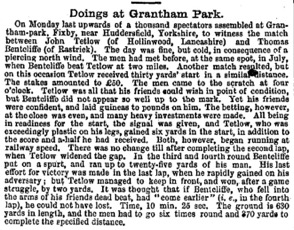
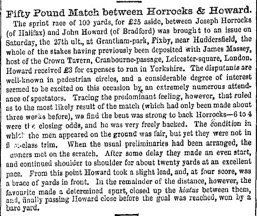
In July 1856, Bintcliffe won a close race with John Tetlow of Hollingwood, Lancashire at Grantham Park over a distance of two miles and a re-match was arranged at the same location in November of that same year, where the stakes were a considerable £50 a side. The race was reported in The Era and revealed that over a thousand spectators turned up to witness the event on a cold day ‘in consequence of a piercing north wind’. Tetlow received 30 yards start and began the race well, running at what the report describes as ‘railway speed’. Bintcliffe started to catch him in the final two laps but Tetlow won by two yards in a time of 10 minutes 25 seconds. The report also tells us that‘the betting, however, at the close was even and many heavy investments were made’.
The gambling fraternity did not care much for racers who did not appear to give 100% and subsequently lost them money. Bintcliffe had beaten a rival called Trainor from Liverpool in 1857 and the race report states that Bintcliffe passed the mark first by rather better than a yard. On finishing, Trainor tried to gammon the spectators that he was dead beat; but the ruse would not do, and on entering the public house he was received with a volley of groans and hisses. We hope that in future the gate money will be withheld from parties not running on the “square.”
Thomas Bintcliffe continued to be involved in the sport until November 1861 when he was well beaten in a race by Alfred Day at the Warren House course in Huddersfield. He appears to have disappeared from the racing scene after that contest but no doubt any money he earned during his career would have been a welcome addition to his regular wages as a hand loom weaver. He died at Rastrick in 1886 at the age of 54 years.
Short distance races were also a popular segment of the racing programme at Grantham Park, one such race was over 100 yards between Joseph Horrocks of Halifax and John Howard of Bradford on the 27thDecember 1856 where the winning prize was £50. The Era reported on the event stating that ‘a considerable degree of interest seemed to be excited on this occasion by an extremely numerous attendance of spectators’
The demise of Thomas Bintcliffe’s running career seems to correspond with the demise of pedestrian races at Grantham Park and also Mr. Barratt handing over the reins of the Black Bull at Upper Edge to James Firth in early 1861 as there are no further reports of races after December 1860.

KNUR AND SPELL
Competitions were held at Grantham Park where, not surprisingly, wagers exchanged hands and prize money was at stake between the competitors. There seems to be a continuing theme here doesn’t there? The object of Knurr and Spell was to hit a small ball as hard and as far as you possibly could. The ball or knurr was about the size of a walnut and was thrown into the air by means of a levered wooden trap. The knurr was ceramic and was made from a special clay which was fired at a very high temperature and weighed half of one imperial ounce. When the knurr was tossed up, it was struck by a player with a wooden spell which is made up of two parts. It is a bat about 4 feet in length, usually made from ash or hickory with a pommel on the end which was made from a very hard wood such as apple or plum. The pommel was about 6 inches long, 4 inches wide and 1 inch thick. The spell was swung with two hands though there were some shorter spells where only one hand was used. The idea was to hit the knurr for as long a distance as possible. A good player could make distances of over 250 yards.
Each time the knurr is tossed from the trap, it is called ‘a rise’. A game usually consisted of five or ten rises and it was the player who had achieved the furthest distance after the completed number of rises who was declared the winner so it was an ideal game for the gambler as they could bet not only on the winner but who would hit the knurr the longest distance in each rise and who would achieve the longest hit in the game.
Knurr and Spell could not be played in confined areas and Grantham Park was an ideal place for this sport due to its great length. The longest ever recorded knock of the knurr was just over 372 yards by a man from Halifax.
Dependent upon where the game is played, the equipment varies in size and name. The knurr is sometimes called a potty and the spell in some areas is referring to the trap and not the bat used for hitting. Another variation is where the knurr is suspended in a loop of string and hit from a stationary position rather than when it is tossed into the air by the trap.
In some circles, it is said that one of the main reasons the game died out was because of the lack of knurrs as they were all very old and got lost over the years and no-one made them anymore, in fact, no-one knew the exact formula and many attempts to recreate a knurr almost always result in them shattering when they are hit.
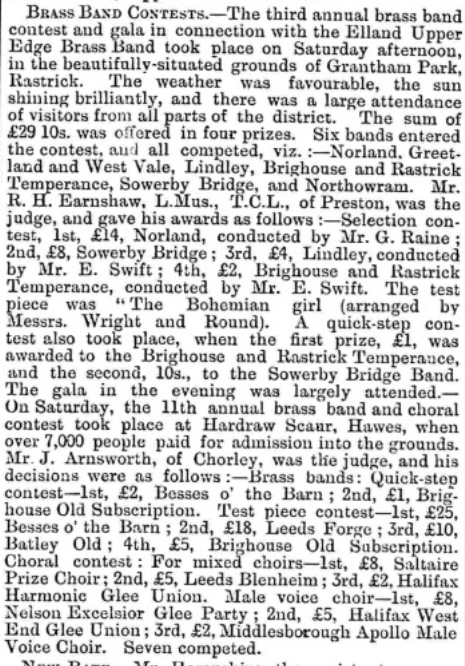
BRASS BAND COMPETITION
The first Brass Band contest at Grantham appears to have been on Saturday 11th May 1889. The adjudicator was Harry North and the test piece was Excelsior by John Round. The results were:-
1st prize – Morley Borough conducted by John Gladney Jnr.
2nd prize – Linthwaite conducted by Edwin Swift
3rd prize – Oats Royd Mills conducted by William Heap
4th prize – Norland conducted by George Raine
5th prize – Rochdale Old conducted by Alexander Owen
On the 23rd June 1891, the contest appears to have been the last before it went to another venue in Elland. The report in the Huddersfield Chronicle states that the contest took place in the beautifully situated grounds of Grantham Park, Rastrick. The weather was favourable and there was a large attendance of visitors from all parts of the district.
Six bands took part, namely Norland, Greetland & West Vale, Lindley, Brighouse & Rastrick Temperance, Sowerby Bridge and Northowram.
There were various prizes amounting to £29-10s
CONCLUSION
The history of the activities at Grantham Park and its use as a major venue for sporting endeavour (together with some serious gambling) is almost lost in the mists of time. It is another location that forms the make-up of the village of Rastrick and makes it so interesting and diverse. Unfortunately, the public lost interest in many of the sports played there as they went out of fashion following the rise in team sports such as football and rugby in the 1870’s onwards. It must have been difficult to play cricket there judging by the scores made by many teams and the two Rastrick clubs at Rastrick Cricket and Athletic Club and New Road Sunday School found better pitches at Round Hill and Badger Hill respectively.
Following the New Road Sunday School cricket team playing there in 1896, there was no further mention of Grantham Park in the local newspapers until the 29th June 1900 when the Brighouse News reported on a quarry accident. The earth banking collapsed onto several men at Walker & Brooke’s Quarry at Grantham Park, injuring some of them. The nearby stone quarrying industry had expanded onto the sports ground and this signalled the end of an era for this former historic sporting and entertainment venue.